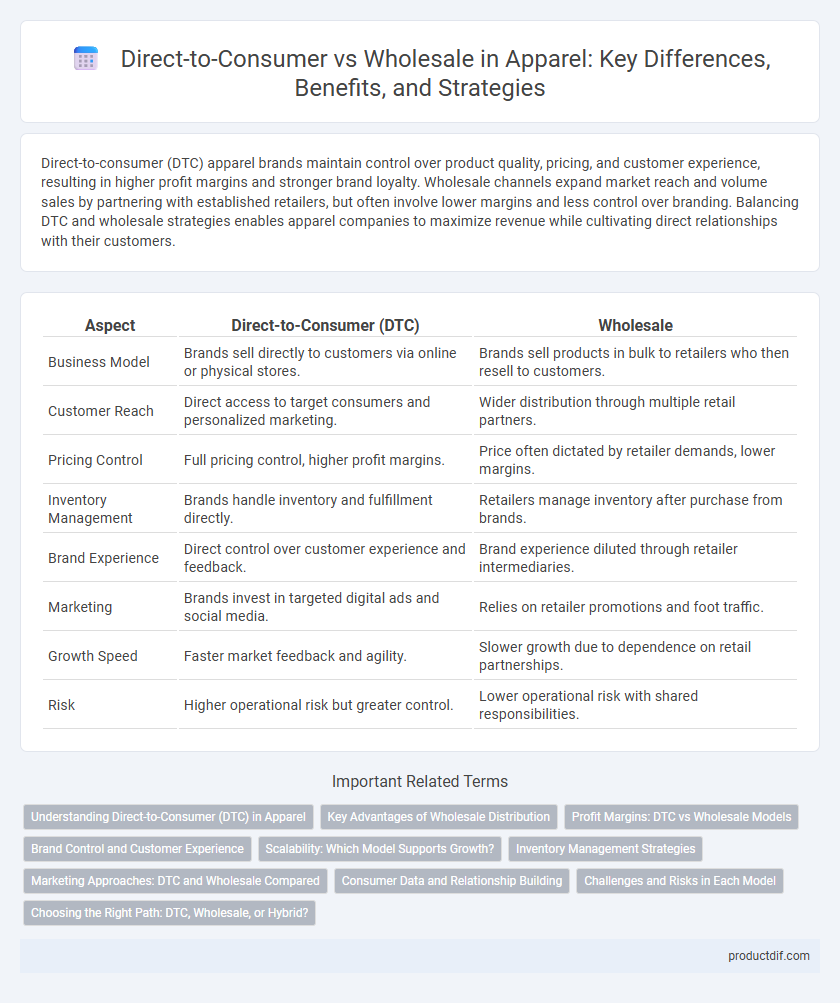Direct-to-consumer (DTC) apparel brands maintain control over product quality, pricing, and customer experience, resulting in higher profit margins and stronger brand loyalty. Wholesale channels expand market reach and volume sales by partnering with established retailers, but often involve lower margins and less control over branding. Balancing DTC and wholesale strategies enables apparel companies to maximize revenue while cultivating direct relationships with their customers.
Table of Comparison
| Aspect | Direct-to-Consumer (DTC) | Wholesale |
|---|---|---|
| Business Model | Brands sell directly to customers via online or physical stores. | Brands sell products in bulk to retailers who then resell to customers. |
| Customer Reach | Direct access to target consumers and personalized marketing. | Wider distribution through multiple retail partners. |
| Pricing Control | Full pricing control, higher profit margins. | Price often dictated by retailer demands, lower margins. |
| Inventory Management | Brands handle inventory and fulfillment directly. | Retailers manage inventory after purchase from brands. |
| Brand Experience | Direct control over customer experience and feedback. | Brand experience diluted through retailer intermediaries. |
| Marketing | Brands invest in targeted digital ads and social media. | Relies on retailer promotions and foot traffic. |
| Growth Speed | Faster market feedback and agility. | Slower growth due to dependence on retail partnerships. |
| Risk | Higher operational risk but greater control. | Lower operational risk with shared responsibilities. |
Understanding Direct-to-Consumer (DTC) in Apparel
Direct-to-Consumer (DTC) in apparel allows brands to sell products directly to customers through online platforms or branded stores, eliminating intermediaries and increasing profit margins. This model enhances customer engagement by providing personalized shopping experiences and real-time feedback, which supports rapid product development and inventory management. Apparel brands utilizing DTC gain valuable first-party data that drives targeted marketing strategies and fosters stronger brand loyalty compared to wholesale distribution.
Key Advantages of Wholesale Distribution
Wholesale distribution in apparel enables brands to access a wider retail network quickly, increasing market penetration and brand visibility. It offers economies of scale by allowing bulk production and sales, reducing per-unit costs and improving profit margins. Wholesale partnerships provide reliable, consistent revenue streams and shared marketing efforts with established retailers, boosting overall brand credibility and consumer trust.
Profit Margins: DTC vs Wholesale Models
Direct-to-consumer (DTC) apparel brands often achieve higher profit margins by eliminating intermediaries and selling products directly to customers through online platforms, capturing full retail prices. Wholesale models typically operate with lower profit margins due to bulk sales at discounted rates to retailers, reducing per-unit revenue. However, wholesale provides greater volume and market exposure, while DTC offers more control over brand experience and customer data, influencing profitability dynamics.
Brand Control and Customer Experience
Direct-to-consumer (DTC) apparel brands maintain full control over brand messaging, pricing, and customer data, enabling a tailored and consistent customer experience that enhances loyalty. Wholesale distribution often dilutes brand control as retailers manage presentation and pricing, potentially impacting how customers perceive the brand. By owning the customer relationship through DTC, apparel companies can implement personalized marketing strategies and directly address customer feedback to elevate satisfaction and retention.
Scalability: Which Model Supports Growth?
Direct-to-consumer (DTC) models offer greater scalability by enabling apparel brands to build direct customer relationships, gather real-time data, and control pricing strategies, fueling personalized marketing and faster growth. Wholesale channels demand large order volumes and reliance on third-party retailers, which can limit agility and slow expansion due to longer sales cycles and inventory commitments. Brands seeking rapid scalability often prioritize DTC for its flexibility in adapting to market trends and directly capturing consumer demand.
Inventory Management Strategies
Direct-to-consumer apparel brands often employ just-in-time inventory management to reduce holding costs and respond swiftly to customer demand, enhancing cash flow efficiency. In contrast, wholesale strategies require maintaining larger inventory volumes to meet retailer order commitments, necessitating robust demand forecasting and warehouse optimization. Both models benefit from integrating real-time analytics and automated replenishment systems to minimize stockouts and overstock risks.
Marketing Approaches: DTC and Wholesale Compared
Direct-to-Consumer (DTC) marketing leverages personalized digital channels like social media, email campaigns, and influencer partnerships to build direct relationships with customers, enhancing brand loyalty and data collection. Wholesale marketing concentrates on B2B strategies, engaging retailers through trade shows, bulk pricing negotiations, and distributor partnerships to scale brand reach and optimize distribution. Effective DTC approaches prioritize customer experience and brand storytelling, while wholesale strategies focus on volume sales and retailer collaboration.
Consumer Data and Relationship Building
Direct-to-Consumer (DTC) apparel brands gain valuable consumer data such as purchase behavior, preferences, and feedback directly from their customers, enabling personalized marketing and product development. Wholesale models limit access to this data since retailers control customer interactions, reducing brands' ability to build strong consumer relationships. Leveraging DTC channels enhances brand loyalty and tailored customer experiences, driving long-term growth and retention in the apparel industry.
Challenges and Risks in Each Model
Direct-to-Consumer (DTC) apparel brands face challenges such as high customer acquisition costs, managing end-to-end supply chains, and maintaining consistent brand experiences, which can strain operational capacities. Wholesale models encounter risks related to lower profit margins, dependence on retailer relationships, and reduced control over brand presentation and customer interaction. Both models demand strategic management of inventory risks and market fluctuations to sustain profitability and growth.
Choosing the Right Path: DTC, Wholesale, or Hybrid?
Choosing the right path between Direct-to-Consumer (DTC), wholesale, or a hybrid model depends on brand goals, target audience, and control preferences. DTC offers higher profit margins and direct customer engagement, while wholesale provides wider distribution and faster inventory turnover. A hybrid model balances the benefits by leveraging brand presence through retail partners while maintaining customer relationships via owned channels for optimal growth.
Direct-to-Consumer vs Wholesale Infographic

 productdif.com
productdif.com